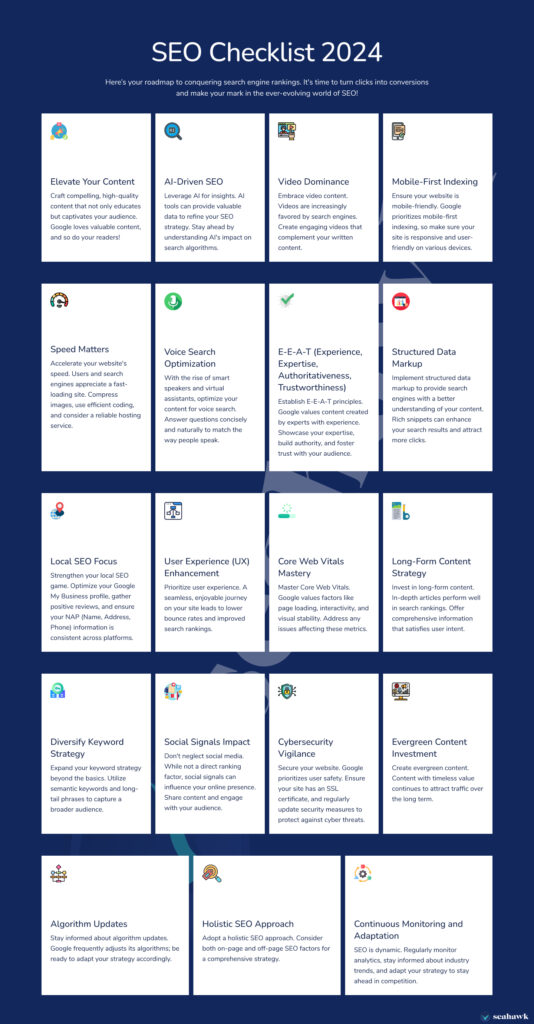Unlock the secrets to maximizing your blog’s visibility with this comprehensive SEO checklist for creating top-notch content that converts.

Image courtesy of via DALL-E 3
Table of Contents
Introduction to SEO
Search Engine Optimization, or SEO in short, is like a secret recipe that makes your blog posts appear higher in search engine results, like Google. Imagine you have a treasure map, and SEO is the key to guiding more people to discover your blog and read what you have to share.
What is SEO?
SEO is all about making your blog posts better so that search engines like Google can easily understand and recommend them to people who are searching for similar topics. It’s like making your blog post shine brightly so that more and more readers can find and enjoy what you write.
Why is SEO Important?
Think of SEO as your magic wand that can bring more visitors to your blog, help you become more popular, and make it easier for people to find the valuable information you have to offer. By using SEO, you can reach more readers and make your blog stand out among the millions of other websites out there.
Choosing the Right Keywords
When it comes to optimizing your blog posts for search engines, one of the most crucial steps is choosing the right keywords. These are the specific words or phrases that your target audience might use when searching for information online. By selecting the appropriate keywords, you can increase the chances of your blog post appearing higher in search engine results and reaching more readers.
What are Keywords?
Keywords are like the secret codes that unlock your blog post for readers searching online. They are the terms that people type into search engines like Google when looking for information. By including relevant keywords in your blog post, you make it easier for search engines to understand what your content is about and match it with the queries of potential readers.
How to Find Keywords
So, how do you find the right keywords for your blog posts? One simple method is to think about what words or phrases your target audience might use to search for information related to your topic. You can also use tools like Google’s search suggestions or online keyword research tools to help you identify popular and relevant keywords.
Additionally, looking at related searches that appear at the bottom of a search results page can give you more ideas for keywords to include in your blog post. By conducting thorough keyword research, you can ensure that your blog post is optimized to attract the right audience and increase its visibility in search engine results.
Crafting Catchy Titles
Creating an engaging title is crucial for attracting readers to your blog posts. A good title should be interesting and informative, giving readers a glimpse of what they can expect to learn from your content. Including relevant keywords in your title also helps improve your search engine optimization (SEO) and makes it easier for people to find your blog online.

Image courtesy of via Google Images
Examples of Great Titles
Here are some examples of catchy titles that effectively incorporate the key features of a good title:
1. “10 Easy Ways to Boost Your Creativity”
2. “The Ultimate Guide to Healthy Eating Habits”
3. “Top Travel Destinations for Adventure Seekers”
By using attention-grabbing words and including the main topic of your blog post, you can create titles that capture the interest of your audience and encourage them to click and read more.
Writing Quality Content
When you write a blog post, it’s essential to keep your content clear and simple. Clear writing helps your readers understand what you’re trying to say without getting confused. Simple language makes it easier for everyone to enjoy and learn from your blog. So, remember to use words that everyone can understand and keep your sentences short and to the point!
Including Useful Information
Adding valuable information to your blog posts is key to keeping your readers engaged and coming back for more. Make sure your content is informative, interesting, and helpful to your audience. Whether you’re sharing tips, stories, or insights, always aim to provide value in every post you write. This way, your readers will see the worth in your blog and keep coming back for more great content!
Using Headers and Subheaders
When writing a blog post, it’s essential to use headers and subheaders to structure your content effectively. Headers and subheaders help break up your text into manageable sections, making it easier for readers to follow along. Let’s explore why using headers and subheaders is crucial for creating a well-organized and reader-friendly blog post.
Image courtesy of via Google Images
Why Use Headers?
Headers play a vital role in organizing your blog post and guiding readers through the information. They provide a clear hierarchy to your content, helping readers understand the main points and the flow of your writing. By using headers, you can grab your readers’ attention and make it easier for them to quickly scan through your post to find the information they’re looking for.
Creating Good Subheaders
Subheaders are like signposts that help readers navigate your blog post smoothly. When crafting subheaders, remember to make them descriptive and intriguing. A well-written subheader should give readers a glimpse of what to expect in the following section. Keep your subheaders concise and relevant to the content that follows to maintain a logical flow throughout your post.
Adding Images and Multimedia
Images play a crucial role in capturing the attention of your readers and making your blog posts more visually appealing. When selecting images for your blog, it’s essential to choose ones that are not only relevant to your content but also interesting and eye-catching. A good image can help convey your message effectively and keep your readers engaged.
Using Videos and Other Media
Aside from images, including videos and other multimedia in your blog posts can add an extra layer of engagement and value for your audience. Videos can help demonstrate concepts, showcase products, or provide additional information that complements your written content. Multimedia elements can make your blog posts more dynamic and appealing, keeping your readers interested and coming back for more.
Internal and External Links
Links are an essential part of creating a well-optimized blog post. By strategically adding internal and external links, you not only improve the user experience but also boost your SEO and increase your blog’s visibility. Let’s dive into the world of links and understand how they can benefit your blog.

Image courtesy of via Google Images
What Are Internal Links?
Internal links are like pathways that connect different parts of your blog together. When you include internal links in your blog posts, you make it easier for readers to navigate through your content. Additionally, internal links help search engines understand the structure of your website and can improve the ranking of your pages in search results.
What Are External Links?
External links, on the other hand, are links that direct your readers to other websites. By including external links to reputable sources, you not only add credibility to your content but also show search engines that your blog is connected to valuable information across the web. This can positively impact your SEO and help drive more traffic to your blog.
Checking SEO with Tools
When it comes to optimizing your blog posts for search engines, it’s essential to take advantage of tools that can help you improve your SEO. These tools are designed to analyze your content and provide valuable insights on ways to enhance your blog’s visibility. Let’s explore how utilizing SEO tools can take your blog to the next level.
Using SEO Tools
SEO tools are like your personal assistants when it comes to ensuring your blog posts are optimized for search engines. These tools help you identify areas where you can make improvements to increase your blog’s visibility and reach a wider audience. By analyzing factors like keyword usage, content quality, and readability, SEO tools provide actionable suggestions to enhance your SEO strategy.
Popular SEO Tools
There are several popular SEO tools available that can help you assess and improve your blog posts. Tools like SEMrush, Ahrefs, and Moz offer features such as keyword research, competitor analysis, backlink monitoring, and more. These tools not only help you optimize your content but also provide valuable insights into your overall SEO performance.
Additionally, Google Search Console and Google Analytics are free tools provided by Google that can help you track your blog’s performance in search results and understand your audience’s behavior. By utilizing these tools, you can gain valuable information to refine your SEO strategy and attract more readers to your blog.
Conclusion and Summary
This ultimate SEO checklist has provided you with essential tips to craft exceptional blog posts that will help your content rank higher on search engines. By following these simple yet effective guidelines, you can attract more readers to your blog and increase its visibility online.

Image courtesy of via Google Images
Going Over the Checklist
In summary, we have covered the importance of SEO and how optimizing your blog posts can lead to increased readership. Selecting the right keywords, crafting catchy titles, writing quality content, using headers and subheaders effectively, incorporating images and multimedia, adding internal and external links, and checking your SEO with tools are all crucial steps in enhancing your blog’s performance.
Taking the First Steps
Now that you have a comprehensive understanding of the SEO checklist, it’s time to take action. Implement these strategies on your own blog and observe the positive impact they have on your content. By consistently applying these SEO techniques, you can elevate your blog to new heights and reach a wider audience.
Want to turn these SEO insights into real results? Seorocket is an all-in-one AI SEO solution that uses the power of AI to analyze your competition and craft high-ranking content.
Seorocket offers a suite of powerful tools, including a Keyword Researcher to find the most profitable keywords, an AI Writer to generate unique and Google-friendly content, and an Automatic Publisher to schedule and publish your content directly to your website. Plus, you’ll get real-time performance tracking so you can see exactly what’s working and make adjustments as needed.
Stop just reading about SEO – take action with Seorocket and skyrocket your search rankings today. Sign up for a free trial and see the difference Seorocket can make for your website!
Frequently Asked Questions (FAQs)
What if I Don’t Have Time for SEO?
It’s completely understandable if you feel like you don’t have enough time for SEO. But don’t worry, you can still make progress by taking small steps. Start by focusing on the basics, like using the right keywords in your blog posts and creating engaging titles. As you become more comfortable with these practices, you can gradually incorporate other SEO techniques into your routine.
Can I Overdo SEO?
Yes, it is possible to overdo SEO. While optimizing your blog posts is crucial for improving your search engine rankings, going overboard with it can actually hurt your website. Search engines like Google value high-quality content that provides value to readers. If you stuff your content with too many keywords or use shady SEO tactics, it can lead to penalties from search engines. It’s important to strike a balance between SEO and creating valuable, engaging content that resonates with your audience. Remember, quality always trumps quantity when it comes to SEO!







